Fermenting Beer with Mangrove Jack's M10 Workhorse Yeast
Published: October 7, 2025 at 7:12:56 PM UTC
This article is a detailed, practical review for homebrewers. It aims to provide clear guidance on using Mangrove Jack's M10 Workhorse Yeast. The content draws from Mangrove Jack product data, community reports, and personal fermentation experiences. It covers performance, temperature range, attenuation, flocculation, and conditioning behavior.
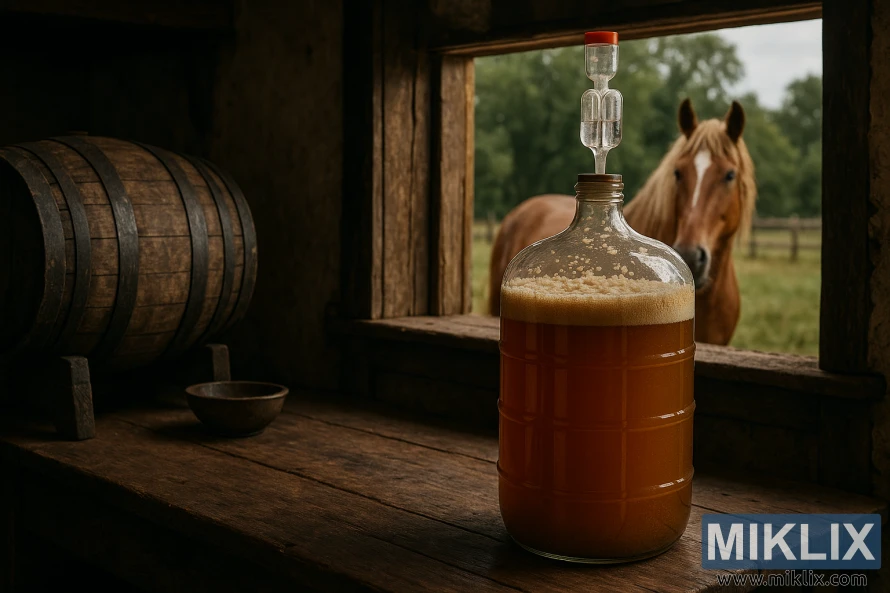
Our focus is on evidence-based advice for fermenting with M10. This includes typical pitch strategies, when to use a starter, and how to handle resumed or uneven fermentations. We compare expected outcomes with real-world results to help brewers set reliable expectations.
Throughout the article, you'll find actionable workflow tips, troubleshooting steps, and flavor expectations for this dry ale yeast M10. Whether you plan cask conditioning, bottle conditioning, or standard kegging, this Workhorse yeast review aims to help you decide when and how to use M10 effectively.
Key Takeaways
- Mangrove Jack yeast review shows M10 as a versatile, high‑attenuating dry ale yeast M10 suited to many styles.
- Fermenting with M10 performs well across a broad temperature range, but control improves flavor and finish.
- Medium flocculation and high attenuation mean good clarity with a dry finish; expect some conditioning time.
- Community reports note occasional resumed fermentations—watch gravity over several days before packaging.
- Use proper pitching rates and simple starter tactics for higher OG beers to get consistent results.
Introduction to Mangrove Jack's M10 Workhorse Yeast
Mangrove Jack M10 basics offer a clear view of a dependable, dry ale yeast. It's a top fermenting dry yeast, sold in packets for easy storage and shipping. The dry format is less sensitive to heat and easier to handle than many liquid strains.
What does M10 Workhorse mean in practical terms? It's a versatile strain for brewers seeking consistent fermentation across various styles. The manufacturer aims for a clean, crisp flavor, ideal for cask, bottle conditioning, and typical ale pours.
The introduction to Workhorse yeast emphasizes its reliability and broad performance. Community feedback and manufacturer specifications lay the groundwork for further discussion on its activity, temperature range, and flavor impact. Homebrewers in the United States will find it handy for a straightforward yeast with minimal storage needs.
Key points to remember:
- Dry, top fermenting dry yeast format for easier transport and storage.
- Marketed for clean, versatile flavor across many beer styles.
- Packaged for homebrewing convenience and consistent pitching.
Key Brewing Properties of Workhorse Yeast
Mangrove Jack's M10 exhibits Workhorse brewing properties that are crucial for both homebrewers and professionals. It has a high fermentable finish, thanks to its "High%" attenuation. This means more sugars are converted into alcohol, resulting in drier beers compared to strains with lower attenuation.
The M10's flocculation is at a medium level. This balance ensures yeast settles effectively without stripping the beer's body too quickly. Brewers can achieve good clarity after a short conditioning period, which is enhanced by cold-crashing or allowing time in the keg or cask.
Information on M10's alcohol tolerance is not provided by the manufacturer. High-gravity batches should be treated with caution, and fermentation activity should be closely monitored. For strong beers, consider step feeding or increasing viable cell counts to prevent stuck fermentations or sluggish attenuation.
As an ale strain, M10 exhibits classic top-fermenting behavior. Expect a pronounced krausen and active surface fermentation early on. This trait aids in temperature management and ensures predictable activity during the first few days.
- Attenuation: leans high, producing drier finishes and efficient sugar conversion.
- Flocculation: medium, enabling reasonable clarity with modest conditioning time.
- Alcohol tolerance: unclear, so plan pitching and nutrient strategies for high ABV targets.
- Conditioning: suitable for cask or bottle refermentation, supporting secondary in-pack conditioning.
Understanding these characteristics is key to aligning recipe design and process choices with Workhorse brewing properties. Adjust mash profiles, oxygenation, and pitching to match M10 attenuation and flocculation for consistent results.
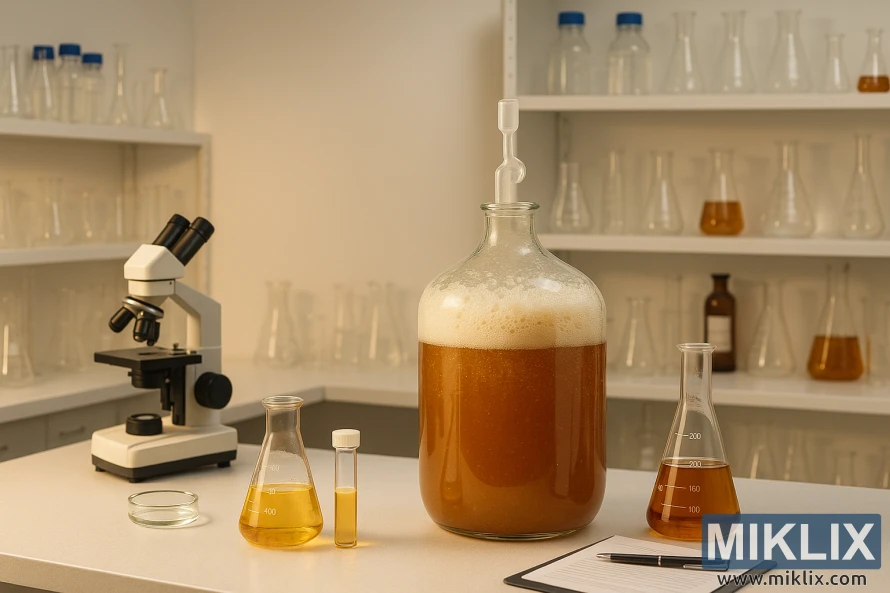
Optimal Fermentation Temperature Range and Effects
Mangrove Jack's M10 Workhorse offers a broad temperature range for fermentation, from 59–90°F. This range accommodates various ale styles, emphasizing the importance of temperature control in shaping flavors.
At the lower end, temperatures around 59–68°F result in a cleaner profile and less pronounced esters. This range is ideal for British ales and recipes where a subtle flavor is preferred over bold fruitiness.
In the mid range, temperatures between 68–75°F strike a balance between ester production and clean attenuation. Brewers can expect reliable, faster fermentation here. Proper management of krausen and aeration is crucial to avoid harshness.
Temperatures above the mid range lead to increased ester production and a higher risk of fusel alcohols and solventy notes. Fermenting at the upper end of the M10 temperature range requires careful planning and staging.
- Lower temps: cleaner esters, subtle character.
- Mid temps: balanced esters, reliable performance.
- High temps: faster fermentation, greater risk of M10 off-flavors.
Dry strains, such as Mangrove Jack's, are resilient against transport heat. Yet, active fermentation heat significantly influences flavor outcomes. It's essential to monitor temperature effects and adjust cooling or warm-up schedules to achieve your desired profile.
Performance in Different Beer Styles
Mangrove Jack's M10 showcases versatility across various M10 beer styles. It's ideal for classic British ales, pale ales, amber ales, and brown ales. This is due to its ability to deliver a clean, moderately attenuated finish. This supports the balance between malt and hop flavors.
The strain's high attenuation makes it perfect for beers needing a drier finish. This characteristic positions M10 as a top choice for crafting stronger bitters or robust porters. These beers require a dry structure without losing flavor.
Mangrove Jack also recommends M10 for lager and Baltic porter, despite being an ale strain. In warm-fermented lagers, it can produce satisfactory results. This is true for both hybrid and traditional styles, provided temperature control is meticulous.
Workhorse for baltic porter is a hit because it brings attenuation and a clean finish. This enhances roasted malt and dark fruit notes. Brewers often opt for M10 in Baltic porter for its ability to create a firmer, drier body.
- Good matches: British ales, pale ales, amber ales, brown ales.
- High-attenuation targets: stronger bitters, robust porters, conditioned stronger beers.
- Conditioning: compatible with cask and bottle conditioning; reliable for re-fermentation.
Steer clear of M10 for beers requiring a pronounced, delicate yeast character. This includes saisons or certain Belgian styles. These beers benefit from specialized liquid strains that promote expressive phenols and esters.
Testing a batch at the intended pitch and temperature is key. Brewers aiming to find the best M10 beers should trial medium-strength ales and a Baltic porter. This will help determine how the yeast influences aroma and finish.
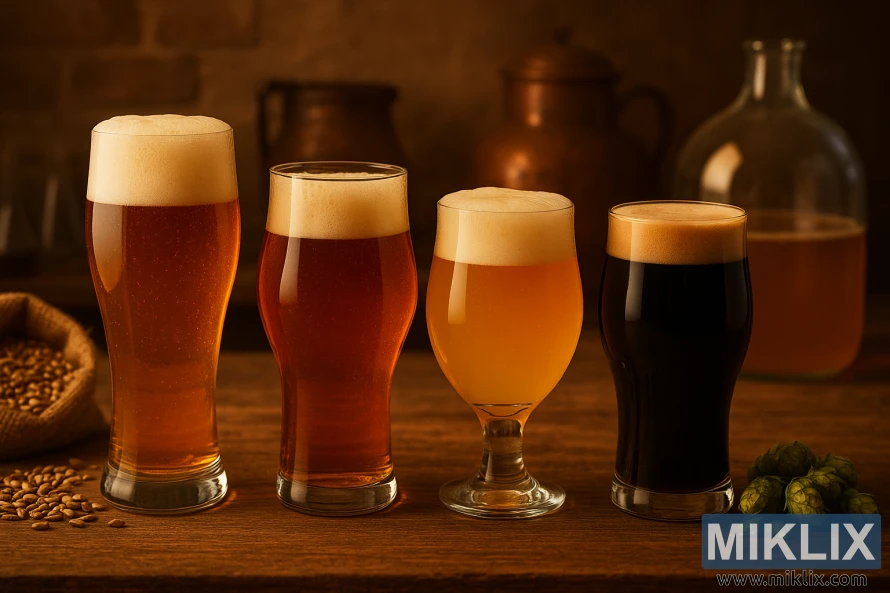
Fermentation Behavior Observations and Anomalies
Brewers have noted unusual M10 fermentation behavior in small batches. A homebrewer, brewing a smoked Danish Skibsøl at 20°C, observed near-complete flocculation after two weeks. The beer then rested for a week, showing minimal change.
In the third week, a vigorous resumed fermentation began, accompanied by fresh krausen. No rousing, temperature shock, or mechanical disturbance was involved. This pattern has raised questions about yeast anomalies in some packets.
Several explanations exist, including a second strain in the packet, a late-fermenting subpopulation of M10, or a wild organism. The S‑33 comparison is relevant, as Safale S‑33 has been known to sporadically reactivate in similar ways.
Practical steps can help manage these surprises. Regularly take gravity readings instead of relying solely on visual signs. If gravity drops again, treat the resumed fermentation as active fermentation, not just degassing.
- Monitor gravity at least twice after apparent finish.
- Allow extra conditioning time when yeast anomalies appear.
- Keep sanitation logs to rule out infection when activity restarts.
These observations indicate that M10 can behave unpredictably in some batches. Recording temperatures, pitch rates, and rehydration methods can help identify patterns if resumed activity occurs.
Pitching Rates, Starter Use, and Dry Yeast Advantages
Dry yeast presents significant advantages for home and craft brewers. It withstands shipping and storage better than most liquid cultures. This means that Mangrove Jack's packs arrive with high viability. For standard gravity recipes, pitching dry M10 at the recommended packet size ensures consistent fermentation.
For higher gravity brews, consider using a dry yeast starter to increase the active cell count. A starter or double starter can create a robust yeast population. This reduces lag time and minimizes the risk of off-flavors in strong worts. For big beers, adjust the M10 pitching rate upward rather than relying solely on a single packet.
Some brewers practice farming dry yeast by creating a starter, splitting it, and pitching half while saving half for future batches. This method acts like simple propagation and is more practical than yeast washing for dry strains. Saved yeast should be treated gently and given a fresh culture step before use to restore vitality.
Decide when to skip a starter based on gravity and recipe goals. For ales at typical gravities, pitching dry M10 without a starter usually works well. For imperial styles and extended fermentations, building a starter or using stepwise feeding is necessary to avoid stress from high alcohol.
When dealing with alcohol tolerance and stalled fermentations, take practical precautions. If the target ABV is unknown, use larger pitch rates, staged increases in wort gravity, or a starter to reduce the chance of a stalled finish. Careful planning around M10 pitching rate and starter strategy improves reliability across recipes.
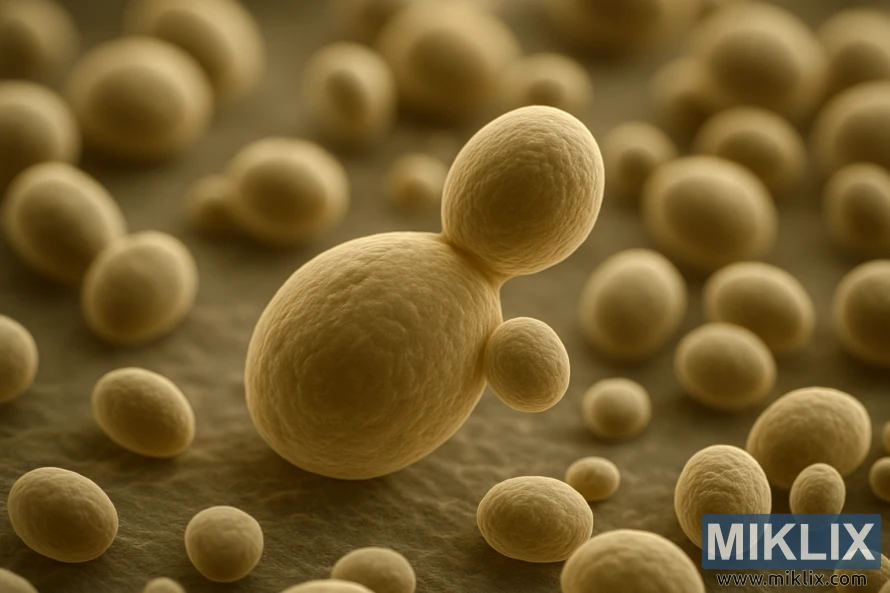
Practical Brewing Workflow with M10 Workhorse
Begin the M10 brewing process by rehydrating the yeast as Mangrove Jack's instructions suggest. Or, use a rehydrate-and-pitch method if the recipe demands it. Lower the wort temperature to the lower end of your target range, around 15–20°C. This helps minimize ester production and maintains a clean flavor profile.
Ensure thorough oxygenation of the wort to support the fermentation process. For batches ranging from 5–20 gallons, aim for dissolved oxygen levels of 8–10 ppm when using pure oxygen. If you opt for aeration through splashing, extend the mixing time to ensure the yeast's health.
- Pitch the recommended cell counts for standard gravities.
- Use a starter for high-gravity beers or lagers that need extra cell mass.
- Consider dry yeast calculators from reputable sources to confirm dose.
Implement a detailed M10 fermentation plan to monitor progress. Take gravity readings every 24–48 hours until they stabilize for three consecutive checks. Observe krausen formation and its decline; M10 often exhibits an active start, but some batches may show delayed vigor.
Strict sanitation is crucial to prevent infection if fermentation appears late or unusual. Clean, sanitized sampling and lids help avoid false positives during the fermenting process.
Allow primary conditioning until the gravity stabilizes. If you plan to bottle or cask condition, ensure there are enough residual fermentables for refermentation. Also, carbonate to the desired level.
Store M10 in a cool, dry environment before use. Avoid prolonged exposure to heat or repeated temperature swings to maintain the viability of this dry yeast format.
Adopt this step-by-step M10 fermentation approach to streamline your brewing, protect the beer's character, and manage timing across batches in both home and professional settings.
Flocculation and Conditioning Considerations
Mangrove Jack's M10 is a medium flocculation yeast. It settles moderately at the end of fermentation. This yeast drops some quickly, leaving others suspended for further cleanup.
Conditioning time for Workhorse is crucial for polishing flavors and clearing haze. Brewers often see near-full flocculation after two weeks at 20°C. Yet, some samples show activity later. Clarity with M10 can be deceiving, indicating fermentation is complete.
Before bottle or cask conditioning, ensure a stable final gravity. M10's flocculation can pause and then resume. Check gravity readings over several days to avoid overcarbonation. This approach minimizes the risk of gushing or bottle bombs from late fermentation.
To enhance clarity with M10, try cold crashing and fining agents like gelatin or kieselsol. Apply these tools after confirming fermentation has stopped. Cold crashing aids in faster settling and clarity without risking CO2 buildup.
- Allow extra primary or secondary time for Workhorse's conditioning needs to clean up esters and diacetyl.
- Take multiple gravity readings before packaging to account for delayed flocculation.
- Use gentle racking and minimal oxygen exposure during transfer to preserve beer stability while yeast settles.
For cask or bottle conditioning, M10 requires patience. Monitor headspace pressure and bottle conditioning temperatures. Adhering to these practices ensures the right carbonation and maintains the beer's intended profile as the yeast finishes its work.
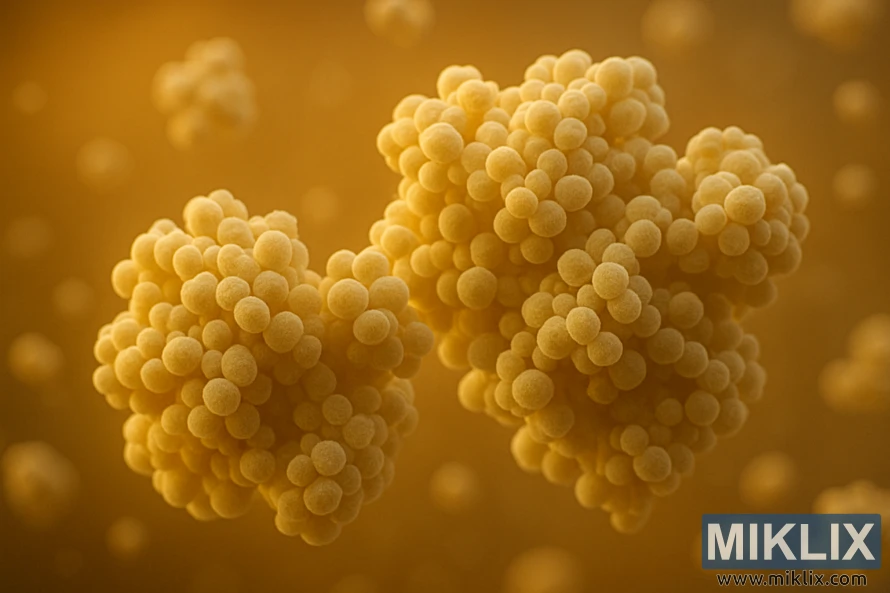
Troubleshooting Common Issues with Workhorse Yeast
Begin M10 troubleshooting by verifying final gravity with a hydrometer or refractometer. Over several days, check if fermentation has truly ceased or if the fermenter shows a false end. This step is crucial to avoid bottling too early and to prevent overcarbonation.
Addressing a Workhorse stuck fermentation early involves examining four common culprits: inadequate oxygenation, insufficient pitching rate, cold wort temperature, and low yeast viability. To revive a sluggish ferment, rehydrate a fresh Mangrove Jack's packet or create a starter before repitching.
If fermentation seems complete but then restarts, explore the cause of this resumed activity. Partial attenuation, mixed strains in a packet, or late contamination can trigger renewed fermentation. Monitor gravity, smell the beer, and note any sudden changes in aroma or tartness.
High fermentation temperatures can lead to solventy or hot fusel notes. Ensure M10 operates within its recommended temperature range. Use temperature control when feasible to minimize off-flavors and maintain a clean profile for both lagers and ales.
- Measure gravity across several days to avoid fixing M10 problems related to overcarbonation.
- Confirm stable final gravity before priming to prevent bottle bombs.
- Use sanitary technique and heat-safe siphons to limit infection risk.
Late or unusual activity might signal infection rather than normal yeast behavior. Look for sourness, vinegar smells, or excessive acetaldehyde. If these signs appear, isolate the batch and assess sanitation and equipment between brews.
For persistent issues, document temperatures, pitch amounts, and pack lot numbers. This record aids in identifying recurring patterns and supports targeted fixes during future M10 troubleshooting or problem-solving in batches.
Comparing M10 Workhorse to Other Dry Yeasts
Mangrove Jack's M10 Workhorse exhibits traits common in mainstream dry ale strains. Its ease of use, steady attenuation, and resilience under varied fermentation schedules stand out. These qualities make it ideal for consistent dry yeast performance in everyday brews.
Comparing Workhorse to familiar options reveals practical differences rather than dramatic ones. M10’s wide temperature range of 15–32°C offers more flexibility than some packaged strains. Its medium flocculation and high attenuation contribute to a cleaner, crisper finish in many recipes.
Some homebrewers discuss S‑33 comparison in forums. Safale S‑33 is known for sporadic resumed activity in bottles for certain recipes. Reports of M10 showing similar behavior are anecdotal and not confirmed by manufacturers. Such observations should be viewed as case notes rather than firm expectations.
- Versatility: M10 vs other dry yeast often favors M10 when a generalist strain is needed.
- Attenuation: M10 leans toward higher attenuation compared with average dry ales.
- Temperature tolerance: choose M10 if your fermentation environment is variable.
Decide based on recipe goals. Opt for M10 if you seek a neutral, attenuative strain that conditions well for bottling or casking. Choose a specialized strain when specific ester production, ester balance, or high alcohol tolerance is crucial.
Practical bench tests are more informative than debate. Run side-by-side batches, track final gravity and flavor, and note any resumed activity or conditioning differences. This empirical approach clarifies real-world differences between M10 vs other dry yeast, guiding future yeast choices.
Tasting Notes and Flavor Profile Expectations
Mangrove Jack's M10 boasts a clean, crisp yeast character. It's perfect for pale ales, lagers, and hybrids. At low fermentation temperatures, the M10's flavor remains subtle, allowing malt and hops to take center stage.
As temperatures rise into the mid range, the M10 reveals mild fruitiness and soft esters. These add a layer of complexity without overpowering the beer. The result is a balanced taste experience.
Be cautious of solvent or fusel aromas at higher temperatures. The M10's flavor can change if wort or fermentation control is off. Staying within stable temperature ranges is key to avoiding unwanted flavors.
High attenuation leads to a drier finish, highlighting the importance of malt, hop bitterness, and adjuncts. The yeast's clean character means residual sweetness is low. This makes dry-hop or late additions more pronounced.
Extended conditioning can reduce diacetyl and smooth out transient compounds. Bottle or cask conditioning enhances mouthfeel and softens the beer's sharpness. It preserves the Workhorse tasting notes beautifully.
Brewer Tips for Best Results in the United States
For optimal fermentation, aim for temperatures between 15–32°C (59–90°F). This range helps minimize sulfur and solvent flavors. Most U.S. brewers target 59–72°F (15–22°C) for a clean, consistent finish.
Choosing the right yeast pitching method is crucial for consistency. For standard gravity ales, direct pitching of Mangrove Jack M10 is often effective. For higher gravity beers or to ensure repeatable results, consider preparing a starter or using the farming method. This approach avoids the need for yeast washing.
- Store dry M10 in a cool, dry spot before use. Dry yeast tolerates heat better than liquid yeast but still benefits from proper storage.
- Take gravity readings across several days instead of relying on visual signs like flocculation. M10 can show late fermentation activity.
- Confirm stable final gravity before priming. This prevents overcarbonation during bottle or cask conditioning.
Cold crashing and using finings can enhance clarity. Yet, never package until the gravity is steady. Rely on consistent measurements for safe conditioning and accurate carbonation.
Sanitation is paramount. Clean, sanitizing practices reduce the risk of contamination affecting fermentation results.
- Control temperature within the recommended band for clean flavor.
- Decide pitching method based on gravity: direct pitch for normals, starter or farming for big beers.
- Monitor gravity over time to confirm completion before packaging.
- Store and handle dry yeast carefully to preserve viability.
These American homebrew tips emphasize practical steps and repeatable workflows. By following U.S. brewing tips M10 and mastering the use of Mangrove Jack M10, brewers can achieve consistent fermentations and superior beer quality.
Conclusion
Mangrove Jack's M10 Workhorse Yeast is a standout in the world of dry ale strains. It offers high attenuation and a clean, crisp finish. This yeast's versatility is evident in its wide fermentation range (59–90°F / 15–32°C) and medium flocculation. It's also easy to use, making it a favorite among homebrewers in the United States.
For those seeking a drier, neutral profile, the M10 is ideal. It's perfect for session ales, pale ales, and beers destined for bottle or cask conditioning. Its ease of use and generalist nature make it a go-to for everyday brewing and small-scale conditioning projects.
Yet, caution is advised. The yeast's alcohol tolerance is not specified. This means it's crucial to be careful with very high gravity beers. Consider using starters or yeast farming for these brews. Always monitor gravity readings and control temperature to avoid off-flavors. Overall, the M10 is a dependable, flexible choice for brewers looking for a straightforward, conditionable strain.
Further Reading
If you enjoyed this post, you may also like these suggestions:
- Fermenting Beer with Mangrove Jack's M42 New World Strong Ale Yeast
- Fermenting Beer with Lallemand LalBrew New England Yeast
- Fermenting Beer with Fermentis SafBrew LA-01 Yeast
